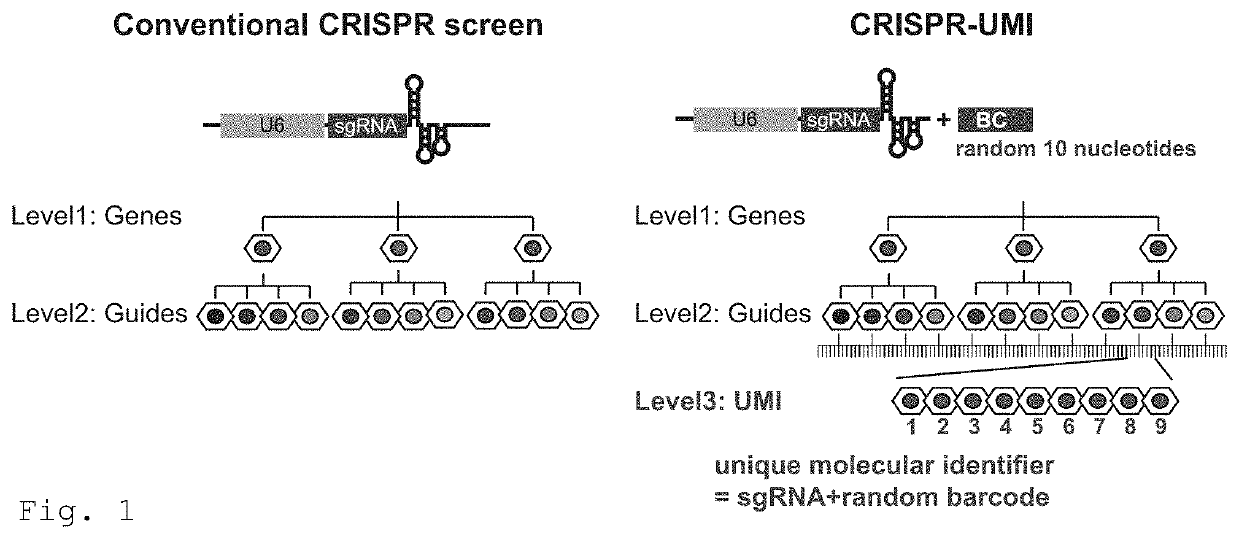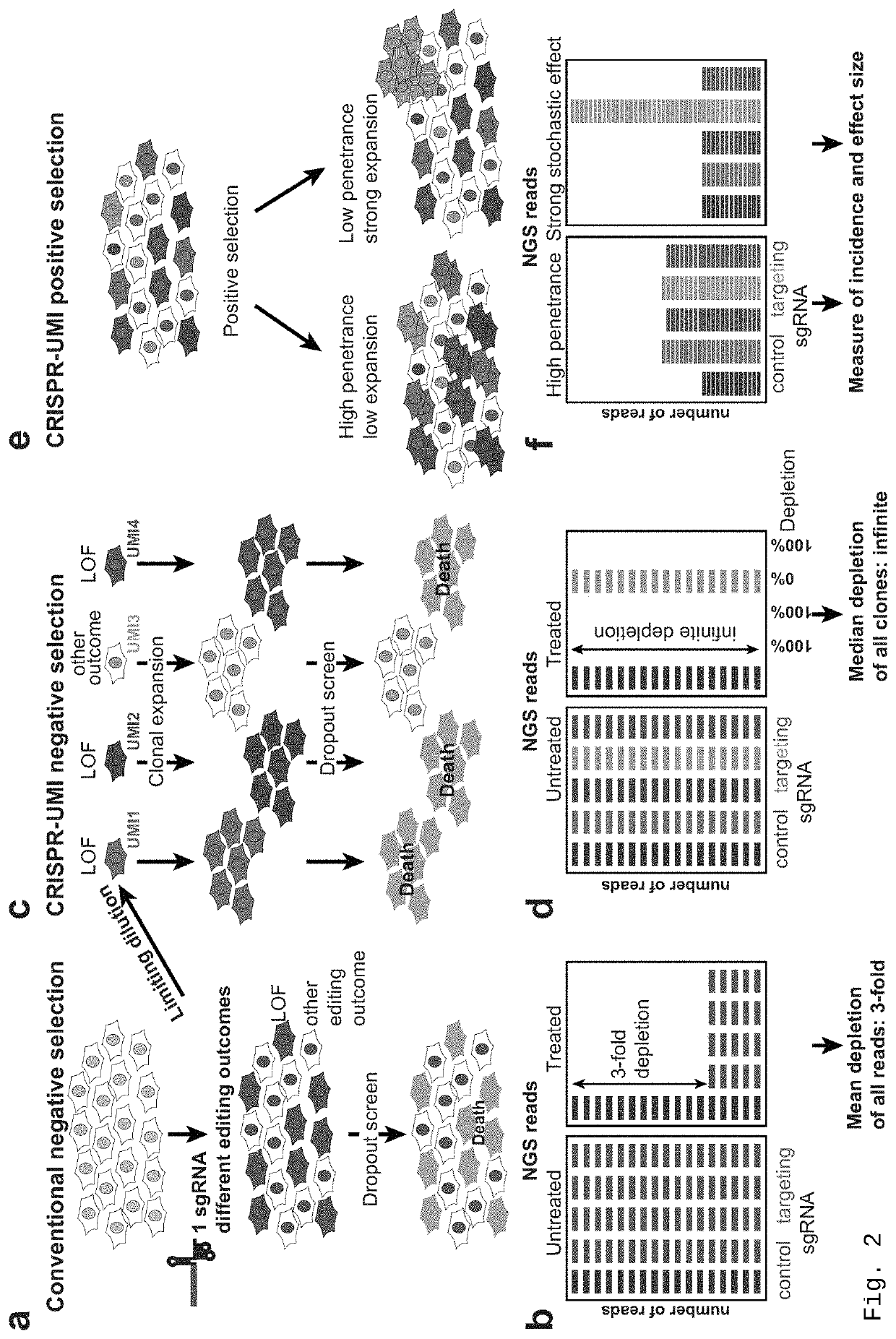Enhanced reprogramming of somatic cells
a somatic cell and reprogramming technology, applied in artificially induced pluripotent cells, non-embryonic pluripotent stem cells, biochemistry apparatus and processes, etc., can solve the problems of inefficient and stochastic ipsc reprogramming process, inability to fully understand key mechanisms and factors contributing to this roadblock, and inability to improve ipsc reprogramming. , to achieve the effect of improving the reprogramming of somatic cells and reducing
- Summary
- Abstract
- Description
- Claims
- Application Information
AI Technical Summary
Benefits of technology
Problems solved by technology
Method used
Image
Examples
example 1
ection
[0116]sgRNAs targeting mouse nuclear genes as well as drugged orthologs and a set of hand selected genes with 4 sgRNAs per gene (5 sgRNAs per gene for the subset drugged genes) were selected by a bioinformatics pipeline. We aimed to design a guide selection algorithm taking both guide efficiency as well as biological effect due to gene structure into account. The basis of the guide selection is the activity score as described by Doench et al. (Nature Biotechnology 32, 1262-1267 (2014)). Additionally, we identified properties of each guide and exon under consideration and penalized the Doench score accordingly. We identified all exonic PAM sites in the mouse genome mm10 (Rosenbloom et al. The UCSC Genome Browser database: 2015 update. Nucleic Acids Res. 43, D670-81 (2015)). We excluded sgRNAs that are incompatible with our cloning strategy (contain: GAAGAC, GTCTCC, CTCGAG, CGTCTC or GAGACG, start with: AAGAC or end with: CTCGA). We then calculated Doench-scores for all potentia...
example 2
loning
[0118]We ordered a gBlock (IDT) flanked by primer binding sites for amplification, restriction sites EcoRI and MfeI for cloning the Illumina i7 primer binding site followed by 10 bp random nucleotide sequence and the Illumina P7 Adaptor. (acgatgagcagagccagaaccagaaggaacttgactctagaGATCGGAAGAG-CACACGTCTGAACTCCAGTCACNNNNNNNNNNgtcctcatctgagagctactcatcaacgg-tATCTCGTATGCCGTCTTaTGCTTGTTAATTAAGAATTCctggacga, SEQ ID NO: 1) (note: we exchanged C to A in the P7 Adaptor Sequence to eliminate a BbS-I restriction site in the adaptor for library cloning, but reintroduced the C during PCR in the DNA-sample prep before NGS). The gBock was digested with EcoRI (NEB R3101L) and MfeI (NEB R3589L) purified on a column (Qiagen 27106) and precipitated with Ethanol. Vector backbone (see FIG. 4a) was digested with XbaI (NEB R0145L) and MfeI (NEB R3589L) and dephosphorylated with rSAP (NEB M0371L), a 1.5 kb stuffer containing a EcoRI restriction site was excised, vector backbone fragments were separated ...
example 3
ulture
[0119]A murine embryonic stem cell clone, derived from a derivative of HMSc2 termed AN3-12, with doxycycline inducible Cas9 (T3G-Cas9-IRES-mcherry PGK-GFP-rtTA) was used for this study. The following ES cell medium (ESCM) was used: 450 ml DMEM (Sigma D1152); 75 ml FCS (Invitrogen); 5.5 ml P / S (Sigma P0781); 5.5 ml NEAA (Sigma M7145); 5.5 ml LGlu (Sigma G7513); 5.5 ml NaPyr (Sigma S8636); 0.55 ml beta-mercapto ethanol (Merck 805740; dilute 10 μl bME in 2.85 ml PBS for a 1000× stock), 7.5 μl LIF (IMBA-MolBioService; 2 mg / ml). Cell culture-grade dishes were from Greiner (Greiner 15 cm 639160) and NUNC (all other formats, e.g. 10 cm dish Nunclon A Surface, cat no. 150350; 6-well Nunclon A Surface, cat no. 140675). Cells were trypsinized and replated every 2nd day and frozen in FCS:ESCM:DMSO=4.5:4.5:1. Cells were tested for mycoplasma every second week. Etoposide treatment: Medium was supplemented every day with 3.3 nM etoposide, an LD30 dose for 8 day treatment (Sigma E2600000), 1...
PUM
| Property | Measurement | Unit |
|---|---|---|
| time | aaaaa | aaaaa |
| time | aaaaa | aaaaa |
| time | aaaaa | aaaaa |
Abstract
Description
Claims
Application Information
 Login to View More
Login to View More - R&D
- Intellectual Property
- Life Sciences
- Materials
- Tech Scout
- Unparalleled Data Quality
- Higher Quality Content
- 60% Fewer Hallucinations
Browse by: Latest US Patents, China's latest patents, Technical Efficacy Thesaurus, Application Domain, Technology Topic, Popular Technical Reports.
© 2025 PatSnap. All rights reserved.Legal|Privacy policy|Modern Slavery Act Transparency Statement|Sitemap|About US| Contact US: help@patsnap.com



